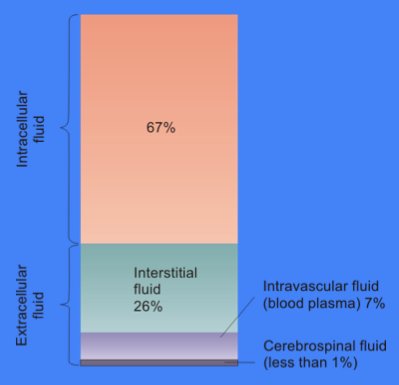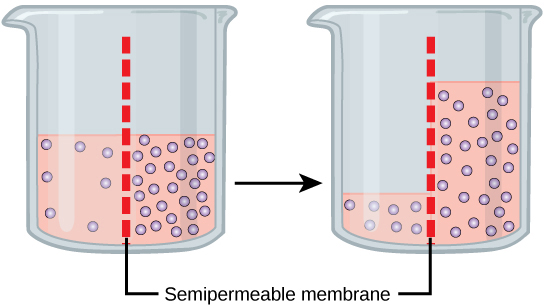7.1: Overview of Fluid and Electrolyte Balance
- Page ID
- 21142
Learning Objectives
- Describe body fluid including intracellular and extracellular fluids.
- Describe osmosis.
A human body is made up of mostly water. An adult consists of about 37-42 liters of water, or about 80 pounds. Fortunately, humans have compartmentalized tissues; otherwise we might just look like a water balloon! Newborns are approximately 70% water. Adult males typically are composed of about 60% water and females are about 55% water. (This difference reflects the differences in body fat content, since body fat is practically water-free. This also means that if a person gains weight in the form of fat the percentage of total body water content declines.) As we age total body water content also diminishes so that by the time we are in our eighties the percent of water in our bodies has decreased to around 45%.
Fluid and Electrolyte Balance
Body fluid is the liquid portion of our cells and tissues. The body fluid composition of tissue can vary. As noted above, the body fluid composition of tissue can vary by:
- Tissue type – lean tissues have higher fluid content than fat tissues
- Sex – males have more lean tissue and therefore more body fluid
- Age – lean tissue is lost with age and body fluid is lost with it
In the human body, body fluid is composed of intracellular fluid and extracellular fluid (Figure \(\PageIndex{1}\)). Intracellular fluid is the fluid that is inside cells; this fluid makes up about 67% of the fluid in an adult. Extracellular fluid is any fluid that is outside of the body's cells. Extracellular fluid is further subdivided into the fluids between cells (interstitial), blood plasma, and other tissue fluids (such as cerebrospinal fluid which surrounds and protects the brain and spinal cord).
Although water makes up the largest percentage of body volume, it is not actually pure water but rather a mixture of cells, proteins, glucose, lipoproteins, electrolytes, and other substances. Electrolytes are substances that, when dissolved in water, disassociate into charged ions. Positively charged electrolytes are called cations and negatively charged electrolytes are called anions. For example, sodium chloride (the chemical name for table salt) disassociates into sodium cations (Na+) and chloride anions (Cl−) when dissolved in water.

Osmoregulation
One of the essential homeostatic functions of the body is to maintain fluid balance and the differences in solute composition between cells and their surrounding environment. Osmoregulation is the control of fluid balance and composition in the body. The processes involved keep fluids from becoming too dilute or too concentrated. Fluid compartments are separated by selectively permeable membranes, which allow some things, such as water, to move through while other substances require special transport proteins, channels, and often energy to move through the membranes. The movement of water between fluid compartments happens by osmosis (Figure \(\PageIndex{2}\)), which is simply the movement of water through a selectively permeable membrane from an area where water is highly concentrated to an area where water is not as concentrated. Water is never transported actively; that is, it never takes energy for water to move between compartments. Although cells do not directly control water movement, they do control movement of electrolytes and other solutes and thus indirectly regulate water movement by controlling where there will be regions of high and low concentrations.

Cells maintain their water volume at a constant level, but the composition of solutes in a cell is in a continuous state of flux. This is because cells are bringing nutrients in, metabolizing them, and disposing of waste products. To maintain water balance a cell controls the movement of electrolytes to keep the total number of dissolved particles the same inside and outside of the cell. Even though the total number of dissolved substances is the same inside and outside a cell, the composition of the fluids can differ. For example, sodium exists in extracellular fluid at fourteen times the concentration as compared to that inside a cell.
If a cell is placed in a solution that contains fewer dissolved particles (known as a hypotonic solution) than the cell itself, water moves into the cell, causing it to swell (Figure \(\PageIndex{3}\)). Alternatively, if a cell is placed in a solution that is more concentrated (known as a hypertonic solution) water moves out of the cell, causing it to shrink. Cells keep their water volume constant by pumping electrolytes in and out in an effort to balance the concentrations of dissolved particles on either side of their membranes. When a solution contains an equal concentration of dissolved particles on either side of the membrane, it is known as an isotonic solution.

Key Takeaways
- Body fluid is the liquid portion of our cells and tissues.
- In the human body, body fluid is composed of intracellular fluid and extracellular fluid.
- Movement of water is regulated by controlling the movement of electrolytes between fluid compartments.
- The movement of water between fluid compartments happens by the process of osmosis.
- Water is never transported actively; that is, it never takes special proteins and energy for water to move between compartments, it simply flows from an area of high concentration to an area where its concentration is lower.
- To maintain water balance, a cell controls the movement of electrolytes to keep the total number of dissolved particles the same inside and outside the cell.

